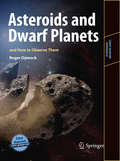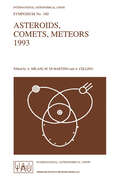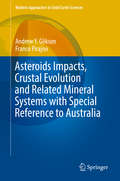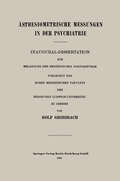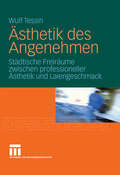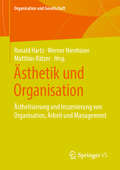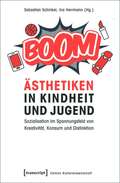- Table View
- List View
Asteroids and Dwarf Planets and How to Observe Them (Astronomers' Observing Guides)
by Roger DymockDwarf planets (which were formerly called asteroids except for the planet Pluto), and the smaller Solar System bodies still called asteroids today, are making front page news, particularly those that are newly discovered and those that might present a hazard to life on Earth by impacting our planet. In this age of giant telescopes and space probes, these small Solar System bodies have advanced from being tiny points of light to bodies worthy of widespread study. This book describes the dwarf planets and asteroids themselves, their origins, orbits, and composition, and at how amateur astronomers can play a part in their detection, tracking, and imaging. The book is divided into two parts. Part I describes physical properties (including taxonomic types) of dwarf planets and asteroids, how they formed in the early life of the Solar System, and how they evolved to their present positions, groups, and families. It also covers the properties used to define these small Solar System bodies: magnitude, rotation rates (described by their light-curves), and orbital characteristics. Part II opens with a description of the hardware and software an amateur or practical astronomer needs to observe and also to image asteroids. Then numerous observing techniques are covered in depth. Finally, there are lists of relevant amateur and professional organizations and how to submit your own observations to them.
Asteroids, Comets, Meteors 1993: Proceedings of the 160th Symposium of the International Astronomical Union, Held in Belgirate, Italy, June 14–18, 1993 (International Astronomical Union Symposia #160)
by A. Milani Mario Badiale A. CellinoTHE MEETING The IAU Symposium 160 ASTEROIDS COMETS METEORS 1999 has been held at Villa Carlotta in Belgirate, on the shore of Lago Maggiore (Italy), from June 14 to June 18, 1993. It has been organized by the Astronomical Observatory of Torino and by the Lunar and Planetary Institute of Houston. It has been a very large meeting, with 323 registered participants from 38 countries. The scientific program included 29 invited reviews, 106 oral communications, and 215 posters. The subjects covered included all the aspects of the studies of the minor bodies of the solar system, including asteroids, comets, meteors, meteorites, interplanetary dust, with special focus on the interrelationships between these. The meeting was structured as follows. 5 morning plenary sessions have been devoted to invited reviews on: (1) search programs (2) populations of small bodies (3) dynamics (4) physical observations and modelling (5) origin and evolution. Two afternoon plenary sessions have been devoted to space missions to small bodies and to interrelationships between the different populations. The afternoon parallel sessions have been devoted to: dynamics of comets; Toutatis, Ida, Gaspra; physical processes in cometary comae and tails; meteorites; the cosmogonic message from cometary nuclei; physics of asteroids; the interplanetary dust complex; comet nuclei; meteors; composition and material properties of comets; dynamics of asteroids.
Asteroids Impacts, Crustal Evolution and Related Mineral Systems with Special Reference to Australia (Modern Approaches in Solid Earth Sciences #14)
by Andrew Y. Glikson Franco PirajnoThis book presents a comprehensive overview of Australian impact structures and related mineralization, including a discussion of the significance of many of these structures for crustal evolution. The book focuses in particular on Archaean impact ejecta/fallout units in the Pilbara Craton of Western Australia, large exposed and buried impact structures, and on the geophysical evidence for possible to probable impact structures. Thanks to their long-term geological stability, Precambrian and younger terrains in the Australian continent contain 38 confirmed impact structures and 43 ring and dome structures, many of which constitute possible to probable asteroid impact structures. The impact structures have been the subject of more than half a century of studies and range from several tens of meter-large craters to buried structures larger than 100 km in diameter. Discoveries of impact fallout units in the Pilbara Craton have defined the Pilbara as one of the two best documented terrains where Archaean impact ejecta/fallout deposits are identified, the other terrain being the Kaapvaal Craton in southern Africa. A synthesis of evidence from both cratons indicates periods of large asteroid bombardments during ~3.47 – 2.48 billion years-ago, including peak bombardment about 3.25—3.22 billion years-ago. The latter period coincides with an abrupt transformation of an early Archaean granite-greenstone crust to mid to late Archaean semi-continental crustal regimes, underpinning the significance of heavy asteroid impact events for crustal evolution. Apart from proven impact structures, Australian terrains display a range of circular features, including morphological and drainage rings, circular lakes, volcanic craters, tectonic domes, oval granite bodies, mafic igneous plugs, salt diapirs, and magnetic, gravity and seismic anomalies, many of which are of a likely impact origin. Thermal and hydrothermal processes associated with impact cratering bear important consequences for the formation of mineral deposits, such as Ni at Sudbury, Pb-Zn at Siljan and Kentland. Impact structures may also provide sites for the accumulation of hydrocarbons, whereas in some instances fracturing associated with impact structures allows outward migration of oil and gas.
Asteroseismic Data Analysis: Foundations and Techniques (PDF)
by Sarbani Basu William J. ChaplinStudies of stars and stellar populations, and the discovery and characterization of exoplanets, are being revolutionized by new satellite and telescope observations of unprecedented quality and scope. Some of the most significant advances have been in the field of asteroseismology, the study of stars by observation of their oscillations. Asteroseismic Data Analysis gives a comprehensive technical introduction to this discipline. This book not only helps students and researchers learn about asteroseismology; it also serves as an essential instruction manual for those entering the field.The book presents readers with the foundational techniques used in the analysis and interpretation of asteroseismic data on cool stars that show solar-like oscillations. The techniques have been refined, and in some cases developed, to analyze asteroseismic data collected by the NASA Kepler mission. Topics range from the analysis of time-series observations to extract seismic data for stars to the use of those data to determine global and internal properties of the stars. Reading lists and problem sets are provided, and data necessary for the problem sets are available online.The first book to describe in detail the different techniques used to analyze the data on stellar oscillations, Asteroseismic Data Analysis offers an invaluable window into the hearts of stars.Introduces the asteroseismic study of stars and the theory of stellar oscillationsDescribes the analysis of observational (time-domain) dataExamines how seismic parameters are extracted from observationsExplores how stellar properties are determined from seismic dataLooks at the “inverse problem,” where frequencies are used to infer internal structures of stars
Asteroseismology (Astronomy and Astrophysics Library #162)
by C. Aerts J. Christensen-Dalsgaard D. W. KurtzUnderstanding the stars is the bedrock of modern astrophysics. Stars are the source of life. The chemical enrichment of our Milky Way and of the Universe withallelementsheavierthanlithiumoriginatesintheinteriorsofstars.Stars arethe tracersofthe dynamics ofthe Universe,gravitationallyimplying much more than meets the eye. Stars ionize the interstellar medium and re-ionized the early intergalactic medium. Understanding stellar structure and evolution is fundamental. While stellar structure and evolution are understood in general terms, we lack important physical ingredients, despite extensive research during recent decades.Classicalspectroscopy,photometry,astrometryandinterferometryof stars have traditionally been used as observational constraints to deduce the internal stellar physics. Unfortunately, these types of observations only allow the tuning of the basic common physics laws under stellar conditions with relatively poor precision. The situation is even more worrisome for unknown aspects of the physics and dynamics in stars. These are usually dealt with by using parameterised descriptions of, e.g., the treatments of convection, rotation,angularmomentumtransport,theequationofstate,atomicdi?usion andsettlingofelements,magneto-hydrodynamicalprocesses,andmore.There is a dearth of observational constraints on these processes, thus solar values areoftenassignedtothem.Yetitishardtoimaginethatonesetofparameters is appropriate for the vast range of stars.
Asteroseismology Across the HR Diagram: Proceedings of the Asteroseismology Workshop Porto, Portugal 1–5 July 2002
by Michael J. Thompson Margarida S. Cunha Mário J. P. F. G. MonteiroWe stand at the threshold of an exciting era of Asteroseismology. In a few months' time, the Canadian small-satellite asteroseismology mission MOST will be laun ched. Danish and French missions MONS and COROT should follow, with the ESA mission Eddington following in 2007/8. Helioseismology has proved spec tacularly successful in imaging the internal structure and dynamics of the Sun and probing the physics of the solar interior. Ground-based observations have detected solar-like oscillations on alpha Centauri A and other Sun-like stars, and diagnostics similar to those used in helioseismology are now being used to test and constrain the physics and evolutionary state of these stars. Multi-mode oscillations are being observed in an abundance of other stars, including slowly pulsating B stars (SPB stars), delta Scuti stars, Ap stars and the pulsating white dwarfs. New classes of pulsators continue to be discovered across the Hertzsprung-Russell diagram. For good reason it was decided to entitle our conference 'Asteroseismology Across the HR Diagram' . Yet the challenges still to be faced to make asteroseismology across the HR diagram a reality are formidable. Observation, data analysis and theory all pose hard problems to be overcome. In conceiving this meeting, the aim of the organisers was to facilitate a cross-fertilization of ideas and approaches between researchers working on different pulsators and with different areas of expertise. We venture to suggest that in this the conference was a great success.
Asteroseismology and Exoplanets: IVth Azores International Advanced School in Space Sciences (Astrophysics and Space Science Proceedings #49)
by Tiago L. Campante Nuno C. Santos Mário J. MonteiroThis book presents the proceedings of the IVth Azores International Advanced School in Space Sciences entitled "Asteroseismology and Exoplanets: Listening to the Stars and Searching for New Worlds". The school addressed the topics at the forefront of scientific research being conducted in the fields of asteroseismology and exoplanetary science, two fields of modern astrophysics that share many synergies and resources. These proceedings comprise the contributions from 18 invited lecturers, including both monographic presentations and a number of hands-on tutorials.
Asteroseismology of Stellar Populations in the Milky Way (Astrophysics and Space Science Proceedings #39)
by Andrea Miglio Patrick Eggenberger Léo Girardi Josefina MontalbánThe detection of radial and non-radial solar-like oscillations in thousands of G-K giants with CoRoT and Kepler is paving the road for detailed studies of stellar populations in the Galaxy. The available average seismic constraints allow largely model-independent determination of stellar radii and masses, and can be used to determine the position and age of thousands of stars in different regions of the Milky Way, and of giants belonging to open clusters. Such a close connection between stellar evolution, Galactic evolution, and asteroseismology opens a new very promising gate in our understanding of stars and galaxies.This book represents a natural progression from the collection of review papers presented in the book 'Red Giants as Probes of the Structure and Evolution of the Milky Way', which appeared in the Astrophysics and Space Science Proceedings series in 2012. This sequel volume contains review papers on spectroscopy, seismology of red giants, open questions in Galactic astrophysics, and discusses first results achieved by combining photometric/spectroscopic and seismic constraints on populations of stars observed by CoRoT and Kepler. The book also reports on discussions between expert researchers in Galactic evolution, specialists in stellar structure and asteroseismology, and key representatives of extensive ground-based spectroscopic surveys such as APOGEE and the ESO-GAIA Spectroscopic Survey, which would serve as a roadmap for future endeavours in this field of research.
Ästhesiometrische Messungen in der Psychiatrie: Inaugural-Dissertation zur Erlangung der Medizinischen Doktorwürde Vorgelegt der Hohen Medizinischen Fakultät der Hessischen Ludwigs-Universität zu Giessen
by Rolf GriesbachDieser Buchtitel ist Teil des Digitalisierungsprojekts Springer Book Archives mit Publikationen, die seit den Anfängen des Verlags von 1842 erschienen sind. Der Verlag stellt mit diesem Archiv Quellen für die historische wie auch die disziplingeschichtliche Forschung zur Verfügung, die jeweils im historischen Kontext betrachtet werden müssen. Dieser Titel erschien in der Zeit vor 1945 und wird daher in seiner zeittypischen politisch-ideologischen Ausrichtung vom Verlag nicht beworben.
Ästhetik: Die Geschichte ihrer Ideologie
by Terry EagletonDie Kategorie des Ästhetischen. Im Denken der Menschen besitzt das Ästhetische eine beherrschende Rolle und besticht durch seine Vielfalt und Wandelbarkeit. Dabei sind Freiheit und Gesetzmäßigkeit, Spontaneität und Notwendigkeit, Fremdbestimmung und Autonomie, Partikularität und Universalität die Erscheinungen, durch die das Ästhetische bestimmt wird. Brillant und provokativ beschreibt Eagelton die vielfältigen Beziehungen zwischen Kunst, Ethik und Politik in der Geschichte des modernen Denkens seit dem 18. Jahrhundert.
Ästhetik als Informationsverarbeitung: Grundlagen und Anwendungen der Informatik im Bereich ästhetischer Produktion und Kritik
by F. NakeDer Computer ist jenes Produktionsmittel, das zur Maschinisierung von Kopf arbeit entwickelt und eingesetzt wird. Behandelt man die Maschinisierung einer besonderen Art der Kopfarbeit, so sieht man sich im Gefiige unserer Wissen schaften einer bestimmten Art von Interdisziplinaritiit gegeniiber: allgemeine und spezielle Methoden der Informatik sind anzuwenden auf spezielle Probleme des besonderen Faches, im vorliegenden Buch auf solche der Asthetik. Ich fasse Asthetik auf als die Produktion und Kritik iisthetischer Objekte und beschreibe die Rolle, die der Computer dabei spielen kann, wobei ich mich vor nehmlich auf die Herstellung von Bildem beziehe. Ein Buch dieses Themas zu schreiben, ist mittlerweile kein auf3ergewohnliches Untemehmen mehr. Neu an unserer Darstellung ist aber meines Wissens die durchgiingige Strenge, also die ausdriickliche und ausfUhrliche Bezugnahme auf Begriffe und Methoden der Informatik. Der Asthetiker erhiilt unmittelbaren und detaillierten Einblick in die Art und Weise, wie sich iisthetische Aufgabenstellungen bei der Programmierung von Computem niederschlagen; gefordert wird von ihm die Bereitschaft, technischen Ausfiihrungen in vielleicht ungewohntem AusmaBe zu folgen. Der Informatiker wird bekannt gemacht mit der modellartigen Aufbereitung iisthetischer Probleme, die er vielleicht fUr "nicht berechenbar" haIt; gefordert wird von ihm das Interesse an Erorterungen auf3erhalb der Thematik blof3er Programmierung. Zwischen diesen beiden Adressatenkreisen versucht der Text eine Briicke zu schlagen. Es ist deswegen weder ein Buch tiber das Informatik-Teilgebiet Graphi sche Datenverarbeitung, noch eines iiber Asthetik im allgemeinen entstanden. Dennoch muB im einzelnen auf Methoden der Informatik einerseits und auf die Einbettung in dengroBeren Problemkreis der Asthetik andererseits eingegangen werden.
Ästhetik der Autonomie: Philosophie der Performance-Kunst (Edition Moderne Postmoderne)
by Hanna HeinrichPerformance-Kunst ist mehr als ein kulturindustrielles Spektakel, denn sie will auf die Beteiligten existenziell einwirken. Hanna Heinrich entwickelt Analysekategorien, die die Kommunikationsmodi dieser Kunstform ebenso wie ihren gesellschaftstransformativen Anspruch philosophisch ergründen. Dazu bedient sie sich der ästhetischen Positionen G.W.F. Hegels, Friedrich Nietzsches, Martin Heideggers, Alain Badious und Michel Foucaults, die der Kunst große emanzipatorische und soziopolitische Kraft zusprechen sowie politischer Philosophien und Ethiken und zeigt damit auf: »Gelungene« Performances stellen sich als exemplarische Handlungsräume mit utopischem Potenzial der gegenwärtigen Entfremdung entgegen und verweisen auf die (Mit-)Verantwortung und Freiheit jedes Einzelnen.
Ästhetik der Kritik oder Verdeckte Ermittlung (Edition Voldemeer Zürich)
Die schillernden Begriffe Ästhetik und Kritik werden in spannender Weise in Beziehung gesetzt. Ästhetik, welche seit ihrer Begründung ars und theoria in einem sein konnte, verstanden als Auslegung der Prinzipien, nach denen Modelle, Fiktionen, Behauptungen, Werke gebaut sind. Ästhetik, verstanden auch als Zerlegung und Rekonstruktion von Erscheinungs- und Bauweisen, von »Architekturen«. Kritik, verstanden als Erörterung der Konstellationen, in denen etwas zu dem geworden ist, was es ist. Kritik verstanden als Unterscheidungs- und Urteilsvermögen, aber auch als eine Kunst der Aus- und Fluchtwege. Die Diskussion der beiden Begriffe und ihrer Beziehung führt uns in seltsame Gefilde, in vertrackte Lagen, in fremde Stuben und an überraschend vertraute Orte: "Die Lösungen liegen immer auf der Strasse, im Verkehr" (Joseph Vogl).
Ästhetik der Metapher: Philosophische und kunstwissenschaftliche Grundlagen visueller Metaphorik (Image #154)
by Till Julian HussMetaphern beeinflussen unser Denken, unsere alltägliche und auch wissenschaftliche Sprache. Sie lassen Ähnlichkeiten erkennen und schaffen neues Wissen. Da unsere Kultur, unser Denken und Handeln aber zunehmend von Bildern geprägt ist, muss es dann nicht auch visuelle Metaphern geben? Und welche Bedeutung misst man ihnen bei? Till Julian Huss arbeitet erstmals die historischen und systematischen Grundlagen einer Theorie der visuellen Metapher aus. Indem das Spannungsverhältnis zwischen Metapher und Begriff sowie Sprache und Bild in den Kontext einer allgemeinen Ästhetik der Metapher gestellt wird, nimmt die Metapher eine Schlüsselfunktion zwischen Sprache, Anschauung und Denken ein.
Ästhetik des Angenehmen: Städtische Freiräume zwischen professioneller Ästhetik und Laiengeschmack
by Wulf TessinArchitekten haben andere ästhetische Vorstellungen als Laien. Zudem täuschen sie sich auch über den Laiengeschmack und dies umso mehr, je weiter ihre professionellen ästhetischen Vorstellungen vom Laiengeschmack abweichen. Diese Diskrepanz zwischen professioneller Ästhetik und dem Laiengeschmack ist Gegenstand dieser Untersuchung. Es soll also einerseits herausgearbeitet werden, welche ästhetischen Ansprüche die Bevölkerung an städtische Freiräume hat, andererseits inwieweit und worin sich diese von der professionellen Ästhetik der Landschaftsarchitekten unterscheiden. Die These ist, dass diese Unterschiede gerade in den letzten Jahrzehnten eher größer geworden sind.
Ästhetik des Brauchtums: Eine empirische Betrachtung deutscher Schützenfestschriften (Kunst- und Designwissenschaft #6)
by Verena Landgraf-FreudenreichDas deutsche Brauchtum erweist sich oftmals als resistent gegenüber gestalterischen Entwicklungen, Zeitgeist und Innovationen. Verena Landgraf-Freudenreich blickt mit ihrer empirischen Studie zu den Titelseiten deutscher Schützenfestschriften genauer auf die alltagsästhetischen Strukturen und macht gestalterische Routinen des Schützenwesens sichtbar. Mit Rückgriff auf Luhmanns Theorie der Autopoiesis werden die Gestaltungsmerkmale analysiert und der Einfluss der Alltagsästhetik auf das Geschmacksurteil sozialer Gruppen erklärt.
Ästhetik des Nihilismus: Von der Romantik zum Modernismus
by Bruno HillebrandVon Nietzsche bis Heidegger. Der Nihilismus als Geistesphänomen und Erlebnis zeigt sich zum ersten Mal in der deutschen Romantik. Er stand im Zentrum von Philosophie und Literatur im 19. Jahrhundert. Im 20. Jahrhundert hat sich der Nihilismus als Kulturphänomen - im Bereich aller Künste - fest etabliert. Mit Blick auf die Herkunft, vor allem auf Nietzsche, beschreibt Bruno Hillebrand die Geschichte der Ästhetik des Nihilismus.
Ästhetik digitaler Medien: Aktuelle Perspektiven (Digitale Gesellschaft #31)
by Martina IdeIn einer immer umfassenderen Weise bestimmen digitale Technologien und soziale Medien Auswahl, Form und Inhalt der Wahrnehmung - und produzieren dabei immer wieder neue (Un-)Sichtbarkeiten. Kulturelle Praktiken als Repertoire von Zeichen, Symbolen und Verhaltensweisen unterliegen einer ständigen Transformation und Bedeutungsumwandlung. Diese Entwicklungsdynamik im Spannungsfeld autooperationaler Formen und kultureller Praxis fordert für die visuell gestützten digitalen Medien eine neue Kategorisierung und Hinterfragung ihrer Ästhetik. Wie ändern sich im Zeitalter der Digitalisierung Begriff und Definition des Ästhetischen und was bedeutet ästhetische Erfahrung im Kontext digitaler Medien?
Ästhetik im Prozeß
by Gerhard RuppÄsthetik im Prozeß: Dieses Stichwort weist darauf hin, daß Literatur, Medien und Kultur heute unter dem Leitkonzept der Ästhetik stehen. Dies gilt für die künstlerische und mediale Präsentation wie für das Selbstbewußtsein von Autoren und Lesern. In einem weiteren Sinn betrifft es die Wissenschaft, die zunehmend von ästhetischen Prozessen bestimmt wird: in ihrer Begriffsbildung, ihrer (Selbst-)Verständigung und ihren Kommunikationsformen. Der Band beleuchtet die Konsequenzen dieses kulturellen Wandels für die literarische Öffentlichkeit und für das Lernen in der Schule.
Ästhetik und Anthropologie bei Alfred Döblin: Vom musikphilosophischen Gespräch zur Romanpoetik (DUV Sprachwissenschaft)
by Johannes BalveÄsthetik und Architektur (Schriftenreihe des Weißenhof-Instituts zur Architektur- und Designtheorie #2)
by Daniel Martin Feige Sandra MeireisDie ästhetische Tradition im Gefolge der Moderne hat die Architektur als randständiges Phänomen behandelt. Eine am Paradigma autonomer Kunst oder an einer kontemplativ verstandenen Theorie ästhetischer Erfahrung orientierte Ästhetik wusste mit der immer auch auf Zwecke bezogenen Architektur nicht immer viel anzufangen. Kants Diktum des interesselosen Wohlgefallens legt davon ebenso Zeugnis ab wie Hegels Verortung der Architektur an der Grenze der Kunst. Die Beiträge des Bandes einschlägiger Expert*innen thematisieren die Frage, was es für die Grundbegriffe der Ästhetik heißen würde, sie ausgehend von der Architektur und damit einer immer auch funktionalen Kunst neu zu denken: Bedürfen Begriffe wie Kunst, Sinnlichkeit, Urteil und Erfahrung einer Reformulierung, um den ästhetischen Eigenarten der Architektur angemessen Rechnung zu tragen?
Ästhetik und Organisation: Ästhetisierung und Inszenierung von Organisation, Arbeit und Management (Organisation und Gesellschaft)
by Ronald Hartz Werner Nienhüser Matthias RätzerDie Beiträge des Bandes diskutieren die Ästhetisierung und Inszenierung von Arbeit, Organisation und Management im Kontext der Diagnose eines ästhetischen Kapitalismus, einer fortschreitenden Kulturalisierung der Ökonomie und des Aufstiegs kreativer, immaterieller und ästhetischer Arbeit. Unternehmen, Arbeitsprozesse, Produkte und Dienstleistungen geraten zunehmend in den Fokus ästhetischer Gestaltung – es geht um Aussehen, Ausstrahlung, Glanz und Atmosphäre. Der Band thematisiert dabei auch problematische Effekte einer Ökonomisierung des Ästhetischen und einer Ästhetisierung der Ökonomie und erschließt somit neue Perspektiven für eine kritische Organisationsforschung.
Ästhetiken des Engagements: Performative Perspektiven im Anthropozän (Theater #162)
by Jan-Tage KühlingWie reagieren die zeitgenössischen performativen Künste auf das »geologische Zeitalter des Menschen«? Jan-Tage Kühling zeichnet die Bezüge zwischen performativer Ästhetik und den Diskursen um das Anthropozän nach. Dabei zeigt er, dass es in Zeiten der Klimakatastrophe kein »Außen« mehr gibt, auf das sich die Ästhetik stützen könnte. Stattdessen sind die performativen Künste fundamental in die erdsystemischen, mehr-als-menschlichen Bezüge eingeschrieben: Sie sind »engagiert«. So werden auch deren Potentiale in Krisenzeiten sichtbar - besonders hinsichtlich der nötigen Transformationen des Denkens und des politischen Handelns.
Ästhetiken in Kindheit und Jugend: Sozialisation im Spannungsfeld von Kreativität, Konsum und Distinktion (Edition Kulturwissenschaft #100)
by Sebastian Schinkel Ina HerrmannIn Kindheit und Jugend ist eine Auseinandersetzung mit ästhetischen Darstellungs- und Wahrnehmungsweisen hochgradig relevant. Die Bedeutsamkeit ästhetischer Positionierungen - etwa durch die Wahl der Kleidung oder Accessoires, durch Make-up oder technische Geräte - kann einerseits als Anzeichen einer sehr erfolgreichen Kommerzialisierung von Kindheit und Jugend gedeutet werden. Andererseits zeugt sie aber auch von einem Gespür, mit dem sich Kinder und Jugendliche die Alltagswelt, in der sie leben, zu eigen machen. Um die sozialen Verhältnisse von Ästhetiken, Ökonomien und Generationenbeziehungen in den Blick zu nehmen, versammelt dieser interdisziplinäre Band Forschungsperspektiven zu Alltagsästhetiken in Kindheit und Jugend.
Ästhetische Chirurgie
by Johannes F. HönigIm Unterschied zur ästhetischen Chirurgie konzentriert sich die plastische Chirurgie auf die Korrektur und Wiederherstellung von Substanzdefekten und Funktionen. Die ästhetische Chirurgie dagegen hat sich zum Ziel gesetzt, die Altersveränderungen zu reduzieren bzw., wenn möglich, zu beseitigen, um letztlich das Aussehen zu verbessern. Diese Aufgabenteilung zwischen ästhetischer und plastischer Chirurgie und das zunehmende Interesse und Bedürfnis an ästhetisch-chirurgischen Eingriffen in der allgemeinen Bevölkerung und bei operativ tätigen Ärzten, führten zur Planung des jetzt vorliegenden Werkes. In dem Buch werden schwerpunktmäßig ästhetisch plastisch durchgeführte Standardoperationen aller Körperregionen beschrieben, die sich in der täglichen Routine bewährt haben. Ziel ist es, dem an diesem Fach interessierten Arzt Prinzipien und Grundlagen zu vermitteln sowie das operative Vorgehen praxisnah zu erläutern.
